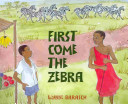
First Come the Zebra
Written/Illustrated by Lynne Barasch
Lee & Low Books, 2009
ISBN: 978-1600603655
The rainy season has passed and the animals begin to migrate into Kenya from Tanzania to graze on the lush tall grass. First come the zebra, then the wildebeest, and finally the gazelles, each eating what they need, nothing more. Abaani, a young Maasai boy, takes his family’s cattle to graze also. The Maasai herd cattle and depend on them for their existence. In the distance Abaani sees Haki from a Kikuyu farm setting up a fruit and vegetable stall along the road. Conflicts between the Maasai and the Kikuyu over land for cattle and farms are on-going and deep-seated. Abaani and Haki argue about the land, echoing their tribes’ rivalry. The argument ends when Kamba women stop to trade their baskets for some of Haki’s fruits and vegetables and a baby wanders into the grass near where some warthogs are grazing. Abaani sees the danger for the baby and knows he and Haki need to act quickly. He yells to Haki to grab the baby while he distracts the warthogs. Together they successfully rescue the child but don’t speak for many days even though they continue to see each other. Eventually they wave, speak, and get to know each other over a game of mancala. Slowly they become friends and decide to begin trading milk from Abaani’s cows and fruit and vegetables from Haki’s farm in the hopes that their families too will become friends.
This story highlights hope, sharing, and cooperation. As the animals share the richness that the grasslands provide, so tribes with different traditions and ways of life can develop an appreciation of each other and what each offers, learn to share resources, and work together. In an Author’s Note Barasch explains that the story was inspired after her trip to Kenya in 2007 where she met Kenyan people, talked with guides, and experienced life in different areas of the country. The Author’s Note includes information about the Maasai and the Kikuyu and how their present day youth are working to bring people together in a peaceful coexistence. The book also contains a map, a pronunciation guide, a glossary, and a list of sources.
Barasch’s illustrations, done in pen and ink watercolors, bring the text alive. Many are double page landscape spreads and highlight the vast grasslands, the animals’ yearly migration, and the beauty of Africa. Barasch’s use of soft colors emphasizes hope and peace for the future.
First Come the Zebra would work well in a text set on resolving prejudices and friendship. Other books in this text set might include Teammates (Peter Golenbock, 1990), Smoky Night (Eve Bunting, 1999) Crossing Bok Chitto: A Choctaw Tale of Friendship & Freedom (Tim Tingle, 2006), and The Other Side (Jacqueline Woodson, 2001).
Prisca Martens, Towson University, Towson, Maryland, USA
WOW Review, Volume III, Issue 4 by Worlds of Words is licensed under a Creative Commons Attribution-NonCommercial-ShareAlike 4.0 International License. Based on work at https://wowlit.org/on-line-publications/review/iii-4/

this is one of my favorites. great review, connected to reality very well.
This is a very unique book written about Maasai culture primarily from the perspective of a pre-adolescent female growing up in that world. A very engaging book in terms of background, cultural perspectives, and the surprising universalities of growing up, regardless of where in the world you are. The female protagonist, Namelok, will undoubtedly give new insight into what it means to be young in Africa to Western readers. This book is particularly enjoyable in terms of how it gives snapshots of what we have already seen about the Maasai culture, Kenya, wild African animals, etc. Yet at the same time, the viewpoint and perspectives of the people inside that culture take it a step further in terms of their modern struggles, survival, traditions, and what that means for the modern day Maasai. What I found particularly interesting are the explanations of how an African tribe views animals and their natural world, along with the ways in which they connect with it. Will that world be lost forever this century? It is a theme that shines through as a common thread running across the pages of this very original book written by a Westerner, Cristina Kessler, under the guidance of Kakuta Ole Maimai Hamisi, a Maasai who helped in the editing of the manuscript. This book stands out as another fine example of African literature, which is a literature that we know little of in North America, and that we undoubtedly need to get much closer to.
For your in formation “wunschkind child without a country” by Liesel Appel as paired in your review of “Traitor” was written by Mrs. Appel where she adapted her memoir “The Neighbor’s Son”for young adult readers. The site is wwwtheneighborsson.com.